EEOC compliance requires employers to maintain fair hiring practices, prevent workplace discrimination, and implement systematic monitoring across all employment decisions. Additionally, this comprehensive checklist addresses critical compliance areas including recruitment, background screening integration, and ongoing workplace monitoring to help employers meet federal equal employment opportunity requirements.
Key Takeaways
- Foundation Requirements: Establish written EEO policies, display required notices, and maintain compliant record-keeping systems for all employment-related documentation.
- Hiring Process Compliance: Structure job postings, interviews, and selection criteria to avoid discriminatory practices while integrating background screening procedures that meet EEOC guidelines.
- Workplace Monitoring Systems: Implement regular compliance audits, employee training programs, and complaint resolution procedures to maintain ongoing adherence to EEOC standards.
- Documentation Standards: Maintain detailed records of hiring decisions, disciplinary actions, and accommodation requests for the required retention periods specified by federal regulations.
- Legal Protection Measures: Develop clear anti-retaliation policies, establish multiple reporting channels, and ensure prompt investigation procedures for discrimination complaints.
- Integration with Background Screening: Align criminal history evaluations, reference checks, and other screening processes with EEOC individualized assessment requirements to minimize disparate impact risks.
Understanding Core EEOC Requirements for Employers
The Equal Employment Opportunity Commission enforces federal laws prohibiting workplace discrimination based on race, color, religion, sex, national origin, age, disability, and genetic information. Moreover, these eeoc requirements employers must follow apply to businesses with 15 or more employees for most protected characteristics. However, age discrimination rules apply to companies with 20 or more workers. Therefore, understanding these foundational requirements forms the basis of any effective workplace compliance checklist.
Furthermore, employers must recognize that discrimination can occur at any stage of employment. This includes recruitment, hiring, training, promotion, discipline, and termination decisions. Additionally, workplace harassment based on protected characteristics creates legal liability even when it doesn't result in tangible employment actions. Consequently, comprehensive compliance programs address both intentional discrimination and policies that create disparate impact on protected groups.
Protected Characteristics and Coverage:
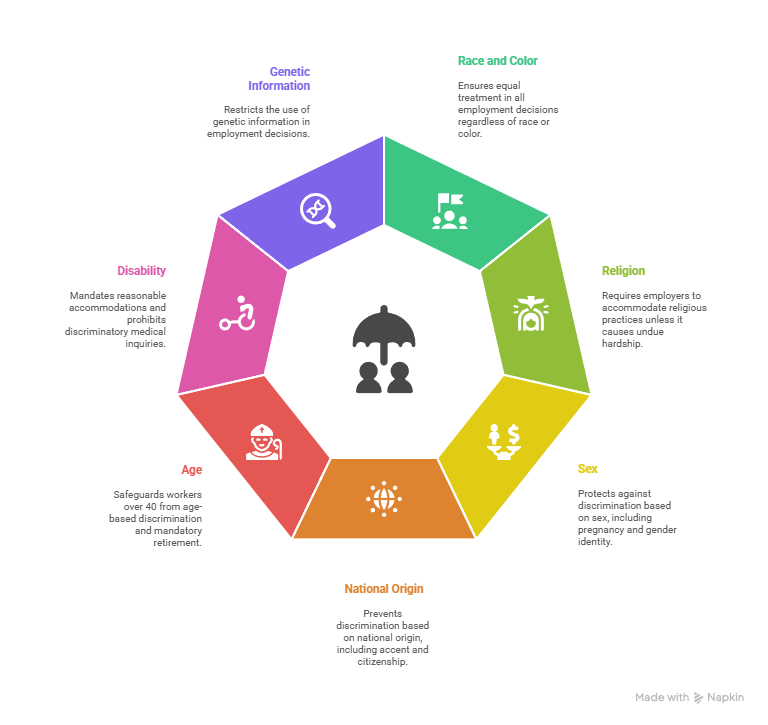
- Race and Color: Applies to all employment decisions including hiring, firing, promotions, and compensation
- Religion: Requires reasonable accommodation unless causing undue hardship to business operations
- Sex: Includes pregnancy discrimination, sexual harassment, and gender identity protections
- National Origin: Covers accent discrimination, English-only policies, and citizenship status requirements
- Age (40+): Protects workers over 40 from age-based employment decisions and mandatory retirement
- Disability: Mandates reasonable accommodations and prohibits medical inquiries during hiring process
- Genetic Information: Restricts use of family medical history and genetic test results in employment decisions
Federal anti-discrimination laws create overlapping compliance obligations that require systematic approach to equal employment practices. Similarly, companies operating in multiple states must also consider additional state and local protections that may extend beyond federal minimums. As a result, effective compliance programs must address the most restrictive applicable law in each jurisdiction.
Essential EEOC Compliance Checklist Components
Comprehensive equal employment compliance begins with establishing clear policies and procedures. Subsequently, organizations must implement these policies consistently across all departments and locations. Most importantly, regular monitoring ensures ongoing adherence to legal requirements and identifies potential issues before they escalate.
Policy Development and Documentation
Every organization needs comprehensive written policies addressing discrimination, harassment, and equal employment opportunity. Furthermore, these policies must clearly define prohibited conduct, outline reporting procedures, and specify consequences for violations. Additionally, regular policy updates ensure alignment with evolving legal requirements and court interpretations.
Effective policies go beyond minimum legal requirements to create inclusive workplace cultures. Therefore, organizations should involve diverse stakeholders in policy development to address practical implementation challenges. Moreover, policies must be accessible to all employees through multiple communication channels and available in appropriate languages for the workforce.
Core Policy Elements:
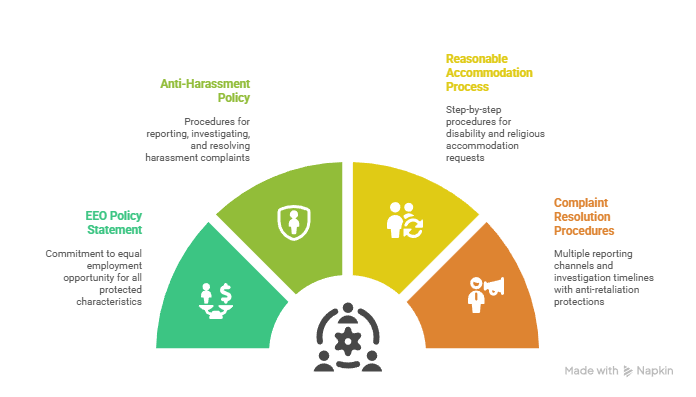
- EEO Policy Statement: Clear commitment to equal employment opportunity for all protected characteristics
- Anti-Harassment Policy: Specific procedures for reporting, investigating, and resolving harassment complaints
- Reasonable Accommodation Process: Step-by-step procedures for disability and religious accommodation requests
- Complaint Resolution Procedures: Multiple reporting channels and investigation timelines with anti-retaliation protections
Required Workplace Postings and Notices
Federal law mandates specific workplace postings informing employees of their rights under EEOC-enforced statutes. Additionally, these notices must be displayed prominently in common areas where employees regularly gather, such as break rooms or human resources offices. However, digital postings may supplement but cannot replace physical displays in most cases.
Furthermore, employers must ensure postings remain current with updated contact information and recent legal changes. Similarly, organizations with remote workers must provide electronic access to required notices through company intranets or email distribution. Consequently, compliance programs should include regular posting audits to verify proper display and content accuracy.
| Posting Requirement | Covered Employers | Display Location |
| EEO is the Law | 15+ employees | Employee common areas |
| Age Discrimination Notice | 20+ employees | Visible to all workers |
| ADA Notice | 15+ employees | Accessible locations |
Recruitment and Hiring Compliance Procedures
Discriminatory practices often begin during recruitment and hiring processes, making this area critical for eeoc compliance checklist implementation. Therefore, job postings, interview questions, and selection criteria must focus on legitimate business requirements. Additionally, employers must avoid language or practices that could discourage protected class members from applying. Furthermore, background screening procedures require particular attention to ensure compliance with EEOC guidance on criminal history considerations.
Effective recruitment strategies actively promote diversity while maintaining merit-based selection processes. Consequently, employers should evaluate their recruitment channels to ensure broad reach across different communities. Moreover, standardized evaluation criteria help ensure consistent assessment of all candidates regardless of protected characteristics.
Job Posting Best Practices:
- Use gender-neutral language and avoid age-specific terms like "recent graduate" or "digital native"
- Focus on essential job functions rather than preferred candidate characteristics
- Ensure posting locations reach diverse candidate pools through multiple recruitment channels
- Include equal opportunity employer statement and accommodation contact information
Pre-employment inquiries must carefully avoid topics related to protected characteristics until after conditional job offers. Similarly, questions about criminal history, medical conditions, or family plans can create legal liability even when asked with good intentions. Therefore, structured interview processes help ensure consistent evaluation criteria across all candidates.
Interview Process Standards
Structured interviews provide the strongest legal protection while improving hiring quality and consistency. Additionally, standardized questions allow fair comparison between candidates based on job-relevant qualifications. Furthermore, interview panels with diverse representation help minimize unconscious bias in evaluation processes.
Interviewers need training on permissible questions and appropriate evaluation methods. Moreover, documentation of interview responses and evaluation rationale supports hiring decisions during potential compliance reviews. Consequently, organizations should develop interview guides that focus on essential job functions and required competencies.
Permissible vs. Prohibited Interview Topics:
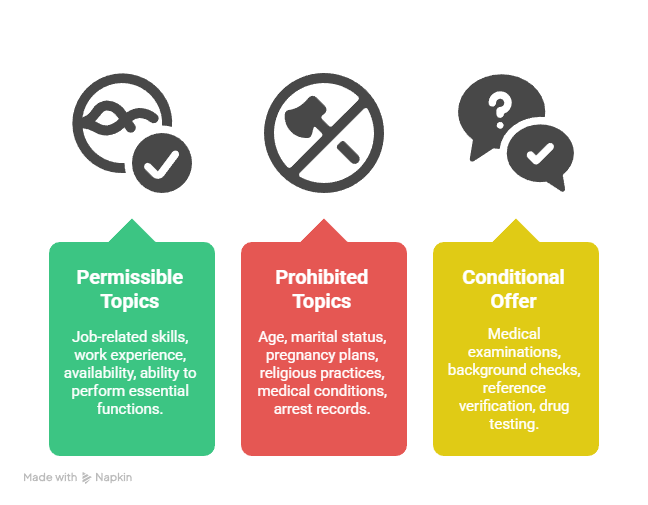
- Permissible: Job-related skills, work experience, availability for required schedule, ability to perform essential functions
- Prohibited: Age, marital status, pregnancy plans, religious practices, medical conditions, arrest records
- Conditional Offer Only: Medical examinations, background checks, reference verification, drug testing
Background Screening Integration Points
Background screening procedures must align with EEOC individualized assessment requirements, particularly for criminal history evaluations. Furthermore, the three-step process requires considering the nature and gravity of offenses, time elapsed since conviction, and relationship between criminal conduct and job responsibilities. Therefore, this approach helps minimize disparate impact while maintaining workplace safety and security.
Additionally, employers must provide opportunities for candidates to explain circumstances surrounding criminal convictions. Similarly, green factors for individualized assessment include rehabilitation evidence, employment history since conviction, and character references from community members. Moreover, companies should document these considerations for each hiring decision involving criminal history to demonstrate good faith compliance efforts.
Criminal History Assessment Process:
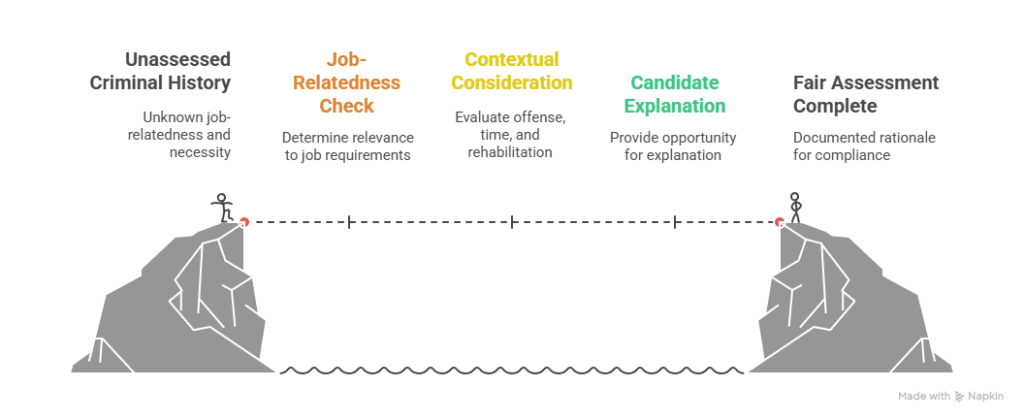
- Step 1: Determine if criminal history is job-related and consistent with business necessity
- Step 2: Consider time elapsed, nature of offense, and rehabilitation evidence
- Step 3: Provide opportunity for candidate explanation and supporting documentation
- Documentation: Record decision rationale and supporting factors for compliance review
Regular training for hiring managers ensures consistent application of these standards across all selection decisions. Furthermore, automated screening systems must incorporate individualized assessment requirements rather than applying blanket exclusions. Consequently, technology solutions should flag cases requiring human review rather than automatically rejecting candidates.
Reference and Credential Verification
Reference checks must follow the same non-discriminatory principles as other screening procedures. Additionally, reference questions should focus on job performance, reliability, and professional conduct rather than personal characteristics. Furthermore, employers should verify that reference providers have direct knowledge of the candidate's work performance.
Professional credential verification helps ensure candidates possess required qualifications while avoiding discriminatory assumptions. Moreover, employers must provide reasonable accommodations for candidates with disabilities during testing or verification processes. Consequently, standardized verification procedures protect both legal compliance and hiring quality.
Workplace Monitoring and Ongoing Compliance
Continuous monitoring identifies compliance gaps and emerging issues before they result in formal complaints or investigations. Therefore, systematic data collection and analysis help organizations maintain proactive compliance programs. Additionally, regular assessments demonstrate good faith efforts to prevent discrimination and address identified problems.
Regular Compliance Audits and Reviews
Systematic compliance monitoring identifies potential issues before they escalate into formal complaints or investigations. Furthermore, annual reviews of hiring patterns, promotion rates, and disciplinary actions help detect statistical disparities that might indicate discriminatory practices. Additionally, these equal employment compliance audits should examine both intentional discrimination and policies with disparate impact on protected groups.
Effective audit programs combine quantitative analysis with qualitative assessment of policies and procedures. Moreover, external auditors may provide objective evaluation and specialized expertise in complex compliance areas. Consequently, organizations should address identified deficiencies promptly and document corrective actions taken.
Audit Focus Areas:
- Recruitment Metrics: Application rates, interview selections, and hiring ratios by protected characteristics
- Promotion Patterns: Advancement opportunities, performance evaluation scores, and leadership development participation
- Compensation Analysis: Pay equity studies comparing similarly situated employees across demographic groups
- Disciplinary Actions: Consistency of progressive discipline and termination decisions
- Accommodation Requests: Response times, approval rates, and effectiveness of provided accommodations
Data collection for compliance monitoring must balance legal requirements with privacy considerations. Similarly, anonymous demographic surveys and voluntary self-identification forms help gather necessary information while respecting employee privacy preferences. Therefore, organizations should clearly communicate the purpose of data collection and protection measures in place.
Employee Training Programs
Comprehensive training programs ensure all staff understand their rights and responsibilities under federal anti-discrimination laws. Additionally, managers require additional training on complaint handling, accommodation procedures, and recognition of potential discrimination issues. Furthermore, training effectiveness improves through interactive scenarios, case studies, and regular refresher sessions rather than one-time presentations.
Training content must remain current with legal developments and organizational policy changes. Moreover, different employee groups require tailored training addressing their specific roles and responsibilities. Consequently, organizations should track training completion and assess comprehension through testing or practical exercises.
Training Components by Audience:
- All Employees: Protected characteristics, complaint procedures, anti-retaliation policies, and respectful workplace behavior
- Managers and Supervisors: Investigation techniques, documentation requirements, accommodation processes, and disciplinary consistency
- HR Personnel: Current legal developments, best practices, record-keeping requirements, and agency interaction procedures
- Hiring Teams: Lawful interview questions, selection criteria development, and background screening compliance
Documentation and Record-Keeping Standards
Proper documentation provides essential protection during EEOC investigations and demonstrates good faith compliance efforts. Therefore, organizations must maintain comprehensive records of all employment-related decisions and supporting rationale. Additionally, record retention schedules must comply with federal requirements while considering state and local variations.
Federal regulations specify detailed record retention requirements for employment-related documents, with penalties for inadequate documentation during EEOC investigations. Furthermore, personnel files, application materials, and training records must be maintained for specified periods depending on document type and company size. Moreover, digital storage systems must ensure document integrity and accessibility during compliance reviews.
Retention Schedule Requirements:
| Document Type | Retention Period | Storage Requirements |
| Personnel Files | 1 year minimum | Secure, confidential access |
| Application Materials | 1 year from decision | Include rejected candidates |
| Training Records | 3 years minimum | Completion certificates, content |
| Complaint Files | 3 years from resolution | Investigation notes, outcomes |
| Accommodation Records | Duration of employment + 3 years | Medical information separately |
| EEO-1 Reports | 3 years from filing | Federal contractor requirements |
Documentation quality matters as much as retention periods, since unclear or incomplete records provide little protection during investigations. Additionally, contemporaneous notes, specific incident descriptions, and consistent formatting improve document credibility. Therefore, regular document review helps identify gaps in record-keeping practices before compliance issues arise.
Medical Information Confidentiality
Medical information requires separate storage with restricted access, even when related to accommodation requests or workers' compensation claims. Furthermore, genetic information faces even stricter confidentiality requirements under the Genetic Information Nondiscrimination Act (GINA). Additionally, inadvertent disclosure of protected medical information can create additional legal liability beyond the underlying discrimination claim.
Access to medical files must be limited to personnel with legitimate business need to know. Moreover, accommodation-related medical information should be shared only with supervisors who need to understand workplace modifications. Consequently, organizations should establish clear protocols for medical information handling and provide specific training to authorized personnel.
Medical Information Access Restrictions:
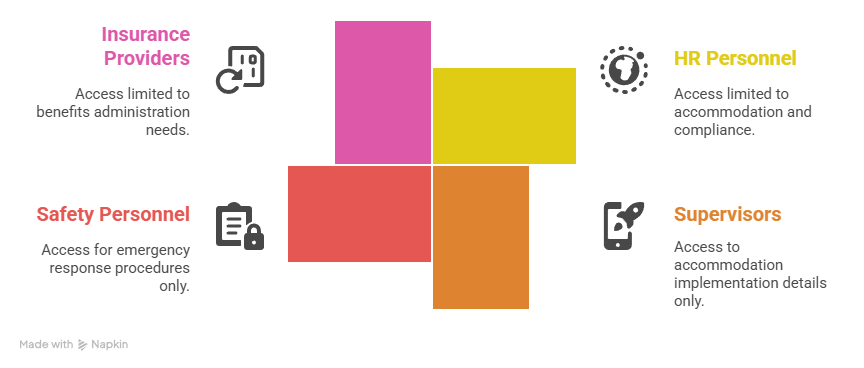
- HR Personnel: Limited to accommodation determination and compliance monitoring
- Supervisors: Only accommodation implementation details, not underlying medical conditions
- Safety Personnel: Necessary information for emergency response procedures only
- Insurance Providers: Only information required for benefits administration
Complaint Resolution and Investigation Procedures
Swift and thorough investigation of discrimination complaints protects both employees and employers from escalating legal issues. Additionally, internal complaint procedures should encourage early reporting while ensuring confidentiality and protection from retaliation. Furthermore, investigation protocols must remain consistent regardless of the accused person's position within the organization or relationship to company leadership.
Effective complaint systems provide multiple reporting channels to accommodate different comfort levels and circumstances. Moreover, organizations should ensure that employees can report concerns without fear of retaliation or career consequences. Therefore, clear communication about complaint procedures and outcomes helps maintain trust in the process.
Investigation Process Steps:
- Initial Complaint Receipt: Document complaint details, identify potential witnesses, and ensure complainant safety
- Preliminary Assessment: Determine investigation scope, potential policy violations, and interim protective measures
- Evidence Gathering: Interview relevant parties, review documentation, and collect physical evidence
- Analysis and Findings: Evaluate credibility, apply company policies, and determine appropriate corrective action
- Resolution and Follow-up: Implement remedial measures, monitor for retaliation, and document closure
Investigation timelines should balance thoroughness with promptness, typically completing most investigations within 30-60 days depending on complexity. Additionally, longer investigations require periodic updates to involved parties and documentation of delays. Therefore, external investigators may be necessary when complaints involve senior management or require specialized expertise.
Anti-Retaliation Protections
Retaliation claims often prove easier to establish than underlying discrimination allegations, making prevention crucial for legal compliance. Furthermore, protected activities include filing EEOC complaints, participating in investigations, and opposing discriminatory practices through internal channels. Additionally, adverse actions taken shortly after protected activity create strong inference of retaliatory motive requiring legitimate business justification.
Examples of potential retaliation include schedule changes, job reassignment, exclusion from meetings, negative performance evaluations, and creating hostile work environment. Moreover, supervisors need training to recognize unconscious bias that might influence their treatment of employees who raise discrimination concerns. Therefore, documentation of legitimate business reasons for employment decisions provides important protection when timing suggests possible retaliation.
Retaliation Prevention Strategies:
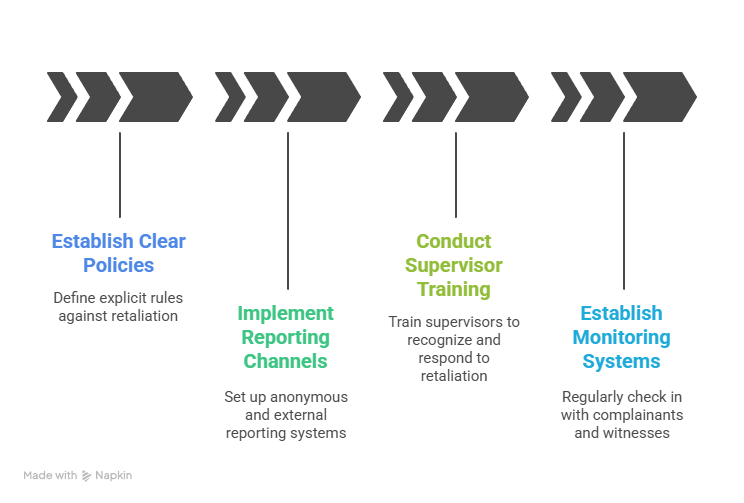
- Clear Policies: Explicit prohibition of retaliation with specific examples and consequences
- Multiple Reporting Channels: Anonymous hotlines, external ombudsman, or third-party reporting systems
- Supervisor Training: Recognition of protected activity and appropriate response procedures
- Monitoring Systems: Regular check-ins with complainants and witnesses to identify potential retaliation
Accommodation Procedures and Best Practices
Reasonable accommodation obligations extend beyond disability-related requests to include religious practices and pregnancy-related limitations. Therefore, organizations must establish clear procedures for receiving, evaluating, and implementing accommodation requests. Additionally, the interactive process requires good faith participation from both employers and employees to identify effective solutions.
Accommodation decisions must consider both employee needs and legitimate business requirements. Furthermore, employers cannot impose undue hardship on operations or compromise essential job functions. However, creative problem-solving often identifies cost-effective accommodations that benefit both parties.
Disability Accommodation Process
The Americans with Disabilities Act requires employers to provide reasonable accommodations for qualified individuals with disabilities unless doing so would cause undue hardship. Additionally, the interactive process begins when employees request accommodations or when employers become aware of potential accommodation needs. Furthermore, medical documentation requirements must be job-related and consistent with business necessity.
Common accommodations include modified work schedules, assistive technology, workspace modifications, and policy exceptions. Moreover, employers should consider multiple accommodation options and allow employee input on preferred solutions. Therefore, documentation of the interactive process demonstrates good faith compliance efforts during potential legal challenges.
Accommodation Evaluation Factors:
- Essential Job Functions: Tasks fundamental to the position that cannot be eliminated or reassigned
- Undue Hardship: Significant difficulty or expense relative to employer size and resources
- Direct Threat: Risk of substantial harm to employee or others that cannot be eliminated through accommodation
- Reasonable Alternatives: Multiple accommodation options that enable job performance
Religious Accommodation Guidelines
Religious accommodation requests require careful balancing of employee beliefs with workplace needs and other employees' rights. Additionally, employers must accommodate sincerely held religious beliefs unless doing so creates undue hardship. Furthermore, religious accommodation may include schedule modifications, dress code exceptions, and workplace practice adjustments.
Common religious accommodations involve scheduling around religious observances, dietary restrictions, prayer time, and religious dress or grooming practices. Moreover, employers should avoid making assumptions about religious requirements and instead engage in dialogue with requesting employees. Therefore, written policies should clarify religious accommodation procedures and examples of potential accommodations.
Pay Equity and Compensation Compliance
Compensation discrimination violates multiple federal laws and requires systematic monitoring to identify and address pay disparities. Therefore, regular pay equity audits help organizations proactively identify potential issues and demonstrate good faith compliance efforts. Additionally, transparent compensation systems reduce the likelihood of discriminatory pay practices and support employee confidence in fair treatment.
Pay equity analysis must consider legitimate factors that may explain compensation differences, such as experience, education, performance, and market rates. Furthermore, statistical analysis should compare similarly situated employees while accounting for relevant variables. Moreover, documented compensation philosophies and structured pay scales provide protection against discrimination claims.
Pay Equity Audit Procedures
Comprehensive pay equity audits examine compensation patterns across protected characteristics while controlling for legitimate business factors. Additionally, statistical analysis should identify both individual pay disparities and systemic patterns that might indicate discrimination. Furthermore, organizations should address identified disparities promptly and document corrective actions taken.
Regular audit schedules ensure ongoing monitoring rather than reactive compliance efforts. Moreover, external consultants may provide specialized expertise and objective analysis of compensation practices. Therefore, audit findings should drive policy improvements and training programs to prevent future disparities.
Audit Components and Analysis:
- Base Salary Analysis: Comparison of base pay for similar positions and qualifications
- Total Compensation Review: Include bonuses, benefits, and other compensation elements
- Promotion and Advancement: Analysis of advancement rates and compensation increases
- Performance Rating Patterns: Evaluation of performance assessment consistency across groups
Technology and EEOC Compliance Integration
Modern HR technology systems can enhance compliance monitoring through automated tracking, standardized processes, and comprehensive reporting capabilities. Furthermore, applicant tracking systems help ensure consistent evaluation criteria and maintain required documentation for hiring decisions. However, algorithmic decision-making tools require careful evaluation to avoid disparate impact on protected groups.
Technology solutions must incorporate compliance requirements rather than treating them as afterthoughts. Additionally, automated systems should flag potential issues for human review rather than making final decisions that could create legal liability. Moreover, regular algorithm audits ensure continued compliance as systems evolve and data patterns change.
Technology Compliance Considerations:
- Applicant Tracking Systems: Ensure equal access for candidates with disabilities and maintain required records
- Video Interviewing Platforms: Provide reasonable accommodations and avoid bias in selection processes
- Background Screening Integration: Implement individualized assessment requirements within automated workflows
- Performance Management Systems: Monitor for patterns suggesting discriminatory application of evaluation criteria
Artificial intelligence and machine learning tools used in hiring require particular scrutiny under EEOC guidance on automated employment decisions. Furthermore, regular algorithm audits help identify potential bias in selection tools, while human oversight ensures consideration of individual circumstances. Therefore, vendors should provide transparency about their tools' potential disparate impact and validation studies.
Data Analytics for Compliance Monitoring
Advanced analytics enable proactive identification of compliance risks through pattern recognition and predictive modeling. Additionally, dashboard systems provide real-time monitoring of key compliance metrics across different business units and locations. Furthermore, automated reporting helps ensure timely identification and response to emerging issues.
Data visualization tools help compliance teams communicate findings to senior leadership and guide strategic decision-making. Moreover, trend analysis identifies whether corrective actions are effectively addressing identified problems. Therefore, organizations should invest in analytics capabilities that support both compliance monitoring and business decision-making.
Emerging Compliance Challenges and Future Trends
The compliance landscape continues evolving through new legislation, court decisions, and regulatory guidance. Therefore, organizations must stay current with legal developments and adapt their compliance programs accordingly. Additionally, remote work arrangements create new challenges for ensuring equal opportunity and accommodation procedures.
Social media and online presence increasingly impact employment decisions and require careful management to avoid discriminatory practices. Furthermore, generational differences in workplace expectations require updated policies and training programs. Moreover, expanded state and local protections often exceed federal requirements and create complex compliance obligations.
Remote Work Compliance Considerations
Remote and hybrid work arrangements require adapted compliance procedures that ensure equal opportunity for all employees regardless of work location. Additionally, accommodation procedures must address home office setups and technology access needs. Furthermore, performance evaluation systems must avoid bias against remote workers while maintaining consistent standards.
Virtual recruiting and interviewing processes need accessibility features and bias prevention measures comparable to in-person procedures. Moreover, training programs must reach all employees effectively regardless of their work location or schedule. Therefore, technology solutions should support compliance requirements across different work arrangements.
Remote Work Compliance Elements:
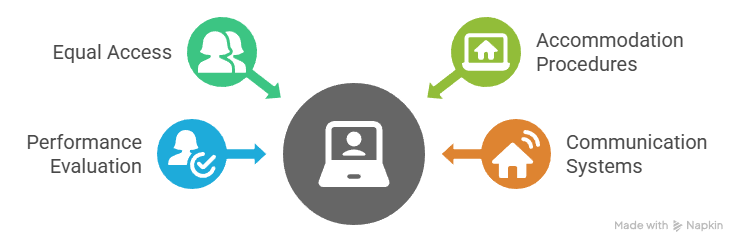
- Equal Access: Ensure remote workers have equal access to opportunities and resources
- Accommodation Procedures: Address home office accommodations and technology needs
- Performance Evaluation: Avoid location bias in performance assessment and advancement decisions
- Communication Systems: Maintain multiple reporting channels accessible to all employees
Conclusion
EEOC compliance requires systematic attention to policies, procedures, and ongoing monitoring across all aspects of the employment relationship. Furthermore, this comprehensive checklist provides the foundation for maintaining legal compliance while fostering inclusive workplace cultures that benefit both employees and business operations. Additionally, regular review and updates ensure continued alignment with evolving legal requirements and best practices. Most importantly, organizations that prioritize equal employment opportunity compliance protect themselves from costly litigation while attracting and retaining top talent from diverse backgrounds.
Frequently Asked Questions
What are the main EEOC compliance requirements for employers?
The main EEOC compliance requirements include maintaining written anti-discrimination policies, displaying required workplace postings, following fair hiring practices, providing reasonable accommodations, investigating complaints promptly, and keeping detailed employment records for specified retention periods. Additionally, employers must train staff on discrimination prevention and establish effective complaint resolution procedures.
How often should companies review their EEOC compliance procedures?
Companies should conduct comprehensive EEOC compliance reviews annually, with quarterly monitoring of key metrics like hiring patterns and complaint trends. Furthermore, policy updates should occur whenever laws change or after significant compliance issues arise. Moreover, ongoing monitoring helps identify potential problems before they escalate into formal complaints.
What happens if a company fails an EEOC compliance audit?
EEOC compliance failures can result in formal investigations, monetary settlements, consent decrees requiring ongoing monitoring, and court-ordered policy changes. Additionally, companies may also face individual lawsuits, reputational damage, and difficulty recruiting qualified candidates. Therefore, proactive compliance programs help avoid these costly consequences.
Do EEOC requirements apply to small businesses?
EEOC requirements generally apply to employers with 15 or more employees for most protected characteristics, though age discrimination rules apply to companies with 20 or more workers. However, some state and local laws may have lower employee thresholds. Therefore, small businesses should check all applicable requirements in their jurisdiction.
How should employers handle criminal background checks under EEOC guidelines?
Employers must conduct individualized assessments considering the nature and gravity of offenses, time elapsed since conviction, and job-relatedness of criminal conduct. Additionally, blanket exclusion policies may violate EEOC guidance on disparate impact. Furthermore, candidates should have opportunities to explain circumstances and provide evidence of rehabilitation.
What documentation is required for EEOC compliance?
Required documentation includes personnel files, application materials, training records, complaint investigations, accommodation requests, and EEO-1 reports (for federal contractors). Additionally, most employment records must be retained for at least one year, with some requiring three years or longer. Moreover, medical information requires separate confidential storage with restricted access.
Can employers ask about disabilities during the hiring process?
Employers cannot ask about disabilities before making conditional job offers, but may inquire about ability to perform essential job functions with or without reasonable accommodation. Furthermore, post-offer medical examinations must be job-related and consistent for all candidates. Therefore, all disability-related inquiries must follow strict EEOC guidelines.
How do state and local anti-discrimination laws affect EEOC compliance?
State and local laws often provide additional protections beyond federal requirements, such as sexual orientation, gender identity, or marital status discrimination. Therefore, employers must comply with the most restrictive applicable law in each jurisdiction where they operate. Additionally, compliance programs should address all relevant legal requirements, not just federal minimums.
Additional Resources
- EEOC Compliance Manual for Employers
https://www.eeoc.gov/employers/small-business/compliance - Federal Anti-Discrimination Laws Overview
https://www.eeoc.gov/laws/guidance - Background Check Best Practices Guide
https://www.eeoc.gov/laws/guidance/arrest-conviction - Workplace Accommodation Procedures
https://www.eeoc.gov/disabilities/reasonable-accommodations - Required Workplace Postings Checklist
https://www.dol.gov/agencies/ofccp/posters - EEO-1 Reporting Requirements Guide
https://www.eeoc.gov/employers/eeo1survey - State and Local Anti-Discrimination Laws Database
https://www.shrm.org/resourcesandtools/legal-and-compliance - EEOC Investigation Process Overview
https://www.eeoc.gov/federal-sector/management-directive/investigation-procedures - Pay Equity Analysis Guidelines
https://www.eeoc.gov/laws/guidance/equal-pay-act - Remote Work Compliance Best Practices
https://www.eeoc.gov/newsroom/eeoc-issues-guidance-workplace-harassment
Still have questions?
Get in touch with our team today for a personalized demo and discover how our tailored volume pricing and packages can drive results for your business!
How useful was this page?*
Note: your comments are anonymous. We use them to improve the website. Do not include any personal details.
Visit our FCRA Compliance Tool or leave a message here if you need a response.
From the blog Explore the GCheck Content Hub

How Long Does a Background Check Take? A Complete 2025 Guide
13 Dec, 2023 • 14 min read
The Ultimate Background Check Guide
13 Dec, 2023 • 4 min read
The Ultimate Guide to Employment Background Checks
13 Dec, 2023 • 10 min readThe information provided in this article is for general informational and educational purposes only and should not be construed as legal advice or a substitute for consultation with qualified legal counsel. While we strive to ensure accuracy, employment screening laws and regulations—including but not limited to the Fair Credit Reporting Act (FCRA), Equal Employment Opportunity Commission (EEOC) guidelines, state and local ban-the-box laws, industry-specific requirements, and other applicable federal, state, and local statutes—are subject to frequent changes, varying interpretations, and jurisdiction-specific applications that may affect their implementation in your organization. Employers and screening decision-makers are solely responsible for ensuring their background check policies, procedures, and practices comply with all applicable laws and regulations relevant to their specific industry, location, and circumstances. We strongly recommend consulting with qualified employment law attorneys and compliance professionals before making hiring, tenant screening, or other decisions based on background check information.

